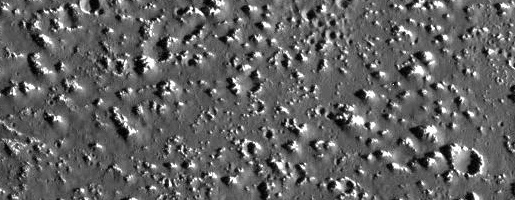 |
||
|
Callisto is one of the most cratered moons in the Solar
System.
|
||
| THE IMPACT BASINS OF CALLISTO | ||
| Valhalla | ||
| The largest feature on the surface of Callisto is the huge multi-ringed impact basin of Valhalla. It is 4000 kilometres across and the largest multi-ring impact basin in the Solar System. | ||
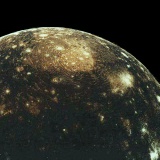 Voyager 1 view of the Valhalla impact basin. |
 The concentric rings of Valhalla. |
|
| Valhalla has a bright central region 300 kilometres across resembling Ganymede's palimpsest terrain. Unlike Orientale on the Moon and Caloris on Mercury which are encircled by 3 or 4 mountainous rings, Valhalla is encircled by about 25 narrow ridges. The rings look bright and stand out well against the dark plains surface. Closer inspection reveals that they are actually scarp faces. The rings are not continuous but are irregular and broken. | ||
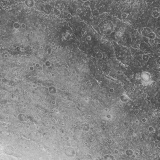 The irregular and broken rings of Valhalla. |
 Galileo close-up view of a Valhalla ring. |
|
| Near the centre the ridges are about 1 kilometre high and 15 kilometres wide. Further out, 300 kilometres from the centre, the ridges are slightly higher. The inner rings are more closely spaced, as well as being lower. Ring spacing ranges from 50 kilometres to 100 kilometres further from the centre. The rings also change form with distance from the centre. Near the centre of Valhalla the scarps face inwards, whereas further out the scarps face outwards. | ||
| The large number of rings, their thinness and close spacing is attributed to Callisto having a thin (about 30 kilometres depth) lithosphere. This is because the top of the crust evidently fractured very easily. A thicker lithosphere might be expected to produce more widely spaced rings with greater topography, such as those seen on the Moon and Mercury. | ||
| Valhalla is also distinguished from other multi-ringed impact basins by its lack of ejecta and secondary craters.The scarp faces which make up the rings indicate a different genesis to the multi-ringed impacts on other bodies. On Callisto the surface may have split into concentric rings when deeper layers flowed back into the depression made by the crater. After a while, subsidence of the main rim beyond the cavity created the outward facing scarps slopes, just as terraces form 'inside' crater rims on more conventional craters.Though the force of impact did erase craters, not all the earlier craters were wiped out by Valhalla. Some survived, showing that the energy of the blast was concentrated near the point of impact. | ||
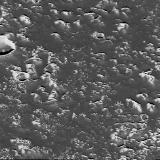 Small craters within Valhalla. |
||
| Asgard | ||
| There is another large impact basin on Callisto called Asgard. Asgard is smaller than Valhalla, just 1200 km across, but it does share many characteristics with its larger counterpart. Asgard too has narrowly spaced rings and a large (200 km) bright central region. The rings encircle the basin but are irregular and interrupted in places. | ||
| Even though there are relatively few craters on the surface of Asgard and Valhalla they are both thought to have been made fairly early in Callisto's history. Callisto has suffered large collisions since the formation of Valhalla and Asgard - both basins feature younger craters. The ejecta from Burr crater, for example, clearly covers the older rings of Asgard. | ||
 Asgard basin and Burr crater. |
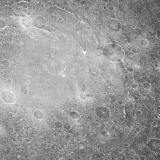 Wide-angle view of Asgard. |
|
| Images of Asgard in the near-infrared part of the spectrum show that the basin centre consists of material more ice-rich than the surrounding area. This implies that objects impacting on Callisto have excavated subsurface ice-rich material, and that the unmodified surface is covered with a darker material. | ||
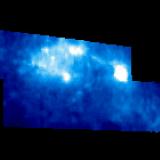 Near-infrared view of Asgard, showing ice composition. |
||
|
|
||